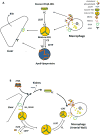Reconstituted high-density lipoprotein therapies: a cause for optimism
- PMID: 25142879
- PMCID: PMC4560112
- DOI: 10.1161/ATVBAHA.114.304156
Reconstituted high-density lipoprotein therapies: a cause for optimism
Keywords: ATP-binding cassette transporter 1; CSL112; acute coronary syndrome.
Figures

Comment on
-
CSL112 enhances biomarkers of reverse cholesterol transport after single and multiple infusions in healthy subjects.Arterioscler Thromb Vasc Biol. 2014 Sep;34(9):2106-14. doi: 10.1161/ATVBAHA.114.303720. Epub 2014 Jun 26. Arterioscler Thromb Vasc Biol. 2014. PMID: 24969776 Clinical Trial.
References
-
- van Capelleveen JC, Bochem AE, Motazacker MM, Hovingh GK, Kastelein JJ. Genetics of HDL-C: a causal link to atherosclerosis? Current atherosclerosis reports. 2013;15:326. - PubMed
-
- Group HTC, Landray MJ, Haynes R, Hopewell JC, Parish S, Aung T, Tomson J, Wallendszus K, Craig M, Jiang L, Collins R, Armitage J. Effects of extended-release niacin with laropiprant in high-risk patients. N Engl J Med. 2014;371:203–12. - PubMed
-
- Boden WE, Probstfield JL, Anderson T, Chaitman BR, Desvignes-Nickens P, Koprowicz K, McBride R, Teo K, Weintraub W. Niacin in patients with low HDL cholesterol levels receiving intensive statin therapy. The New England journal of medicine. 2011;365:2255–67. - PubMed
-
- Schwartz GG, Olsson AG, Abt M, et al. Effects of dalcetrapib in patients with a recent acute coronary syndrome. The New England journal of medicine. 2012;367:2089–99. - PubMed
Publication types
MeSH terms
Substances
Grants and funding
LinkOut - more resources
Full Text Sources
Other Literature Sources
Medical

